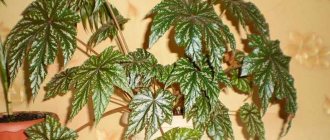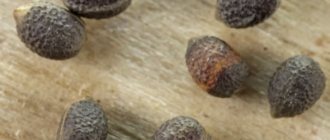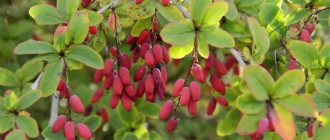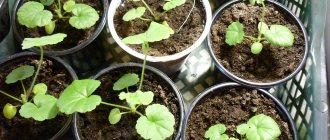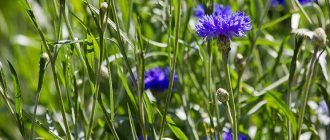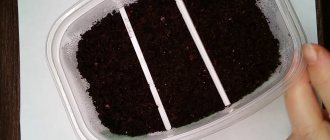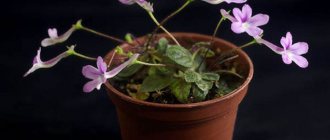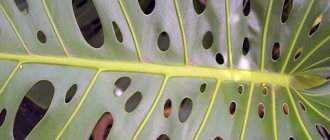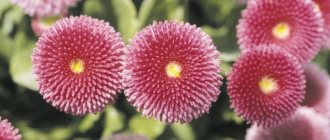Author: Elena N. https://floristics.info/ru/index.php?option=com_contact&view=contact&id=19 Category: Garden plants Published: February 28, 2019Last edits: January 13, 2021
- When to plant
- Growing conditions
- How and when to collect seeds
- Bergenia stracheyi (Вergenia stracheyi = Вergenia gorbunowii)
- Medicinal properties
The herb bergenia, or bergenia (lat. Bergenia), forms a genus of perennials of the Saxifraga family. These perennial herbs grow in the temperate zone from Korea and China to the countries of Central Asia, settling in rock cracks or on rocky soil. Bergenia was introduced into culture in the middle of the 18th century under the name “saxifrage thick-leaved,” but then it was taken into a separate genus and given a Latin name in honor of the German botanist Carl August von Bergen. Scientists know 10 types of bergenia, some of them are grown in cultivation. In addition, breeders have developed dozens of varieties and hybrids of bergenia.
Planting and caring for bergenia
- Planting: sowing seeds in a box for seedlings - before winter, picking seedlings - in early June, planting seedlings in open ground - in early August. The strongest seedlings can be planted in open ground in early June without picking.
- Flowering: timing depends on the species: some can bloom as early as the end of April. Flowering lasts about one and a half months.
- Lighting: partial shade, but can also be grown under diffused light.
- Soil: light, loose, moist, slightly alkaline.
- Watering: if the season is dry, the first watering is done during budding, then during flowering, then after another 2-3 weeks. If precipitation is normal, watering is not necessary.
- Fertilizing: in early spring after pruning, then two weeks after flowering, complex mineral fertilizers in liquid form are applied to the soil.
- Reproduction: by seeds and dividing the bush.
- Pests: slobbering pennies and nematodes.
- Diseases: ramulariasis.
- Properties: the rhizome of the plant has medicinal properties. Preparations made from it have anti-inflammatory, hemostatic, wound-healing, antimicrobial, diuretic, and astringent effects.
Read more about growing bergenia below.
Growing a perennial plant
Most often, seeds are chosen for planting Badan.
Growing bergenia from seeds
Seeds are planted in winter.
- A box or other container is filled with a special soil mixture for flowers;
- Make shallow grooves, about half a centimeter. The distance between is three centimeters;
- Water the grooves with warm water;
- The seeds are carefully laid out and covered with earth;
- The box is buried in the snow in the garden;
- At the beginning of summer, the box is taken out and taken to a cool room.
Growing seedlings
Sprouts appear in the next three weeks. When the top layer of soil dries out, you need to promptly water the plants. The soil must be constantly loosened and the room ventilated. Plants are thinned out.
Excessive watering causes a greenish crust to appear on the surface of the soil. You need to immediately loosen the soil to supply oxygen to the roots.
Botanical description
The genus Badan includes evergreen perennial and annual plants from 6 to 35 cm in height with a thick horizontal rhizome, basal rosettes of large leathery, shiny dark green leaves on long petioles and goblet-shaped flowers of white, red or pink, collected in dense panicles , blooming in late spring or early summer. One inflorescence can have up to 120 flowers. The fruit of the bergenia is a capsule.
Bergenia in landscape design looks very impressive against the background of stones next to variegated and narrow-leaved crops - hostas or phlox. We will tell you everything about how to plant and care for bergenia in the open ground, as well as what the medicinal properties of bergenia are and contraindications.
Description of the bergenia plant
Bergenia flower is a perennial herbaceous plant of the Saxifraga family. It is widely used in Europe for decorating gardens and flower beds; in Russia it is quite rare in garden plots. The plant stretches up to 60 cm in length. The leaves are voluminous, shiny, have a rounded shape, dark green color, and are collected at the root into a rosette. White, pink, blue, purple bells are collected (up to 120 pieces) in thyroid inflorescences. Flower size is up to 2 cm in diameter. Bergenia delights flower growers with its bright blooms from late March to early June.
Growing bergenia from seeds
How to sow seeds
Bergenia is sown before winter. Place flower soil in the box, make grooves 5 mm deep in it at a distance of 3 cm from each other and spill them with warm water, place bergenia seeds in them and seal them. The box is taken out into the yard and placed under the snow. At the beginning of March, a box with crops is brought indoors and kept in partial shade at a temperature of 18-19 ºC.
- Watch how to trim David's buddleia on video
Seedling care
Shoots will begin to appear in three weeks. Caring for bergenia seedlings involves loosening and moistening the soil as its top layer dries, ventilating the room and thinning the seedlings. When a green crust or plaque forms on the surface of the substrate, you need to carefully loosen the soil, because this phenomenon indicates that oxygen has stopped flowing to the roots of the seedlings as a result of excessive watering.
Bergenia pick
In May, bergenia seedlings are planted in a box at a distance of 5-7 cm from each other in a row with a row spacing of 15 cm. A couple of weeks before planting in open ground, hardening procedures begin: the seedlings are taken out to the balcony or terrace every day, gradually increasing the duration of the session. When the seedlings can spend a whole day in the fresh air, they are planted in open ground.
Reproduction methods
Propagation of the culture will require a lot of time and patience. There are 2 methods.
Seeds
Bergenia seeds are black. They must be planted immediately after harvesting in a prepared bed. They are sprinkled with earth on top. It is important to ensure that the soil does not dry out throughout the summer. In winter, the crops should be covered with fallen leaves.
You can sow seeds on the site in May, then seedlings will appear within a few weeks. Next, you need to care for the seedlings as usual. In autumn, we must not forget about covering plants.
It is worth remembering that seedlings develop rather slowly. Over the course of a year, plants grow in height by 25 mm. As soon as the seedlings grow 100 mm, they need to be picked and transplanted to a permanent place. After 4 years, the site will have a strong and flowering plant.
Cuttings
For this method, you need to choose strong and healthy bushes of middle age:
- It is necessary to separate the upper part of the branch with the apical bud and rosette, and remove almost all the foliage.
- Next, plant the cutting. Rooting will be noticeable within a few days.
- The cuttings are planted in pre-prepared soil at a distance of 40 cm from each other. The socket must fit completely into the ground.
- You need to care for cuttings in the same way as for an adult crop.
Planting bergenia in open ground
When to plant
Planting and caring for bergenia is not at all difficult - the plant is unpretentious and resistant to cold. Bergenia is planted in early August. Some gardeners prefer not to pick seedlings, but to immediately plant them in open ground in early June. But sometimes it seems that the seedlings are still too weak for the garden, so plant only the most developed seedlings in June, and pick up the rest and move their planting to August.
How to plant
The bergenia plant has a weak, horizontal root system, so it prefers light, loose, moist and slightly alkaline soils. The roots of the plant often protrude from the ground, and to prevent them from overheating in the sun, choose a place for the plant in partial shade, on the north, north-west or north-east side of the site.
If this is not possible, and you are forced to plant the plant in a sunny area, mulch the soil around the bergenia after planting - this measure will protect the soil from drying out and the bergenia root from overheating. And keep in mind that bergenia does not tolerate even short-term stagnation of water in the roots.
Make holes in the soil 6-8 cm deep, arranging them in a checkerboard pattern 40x40 cm. Throw a handful of sand at the bottom of each hole for drainage, then roll over the seedling with a lump of earth and dig it in. After planting, water the seedlings. Bergenia develops very slowly, so be patient and care. Bergenia blooms from seeds in the third or fourth year.
Diseases and pests
Bergenia thickleaf is resistant to various diseases. However, the stability of the crop depends on proper care; if basic care conditions are not followed, the bergenia may be infected with spotting. Externally, the disease manifests itself as follows:
- the foliage becomes covered with dark spots on the front side;
- A white coating appears on the reverse side.
In order to cure a plant, you need to remove all infected leaves. In addition, you can process bergenia:
- Bordeaux mixture;
- foundationazole;
- drugs with high copper content.
The following pests can cause trouble:
- Penny is slobbering. Provided that the crop grows in dark areas and the moisture level is too high, a pest such as slobbering pennix may appear. It produces saliva that contains larvae. Some plants become covered with saliva, first begin to rot, and then dry up. The disease should be treated with drugs: Tsvetofos or Intavir (1 tablet per 10 liters of water).
- Nematode. A parasite (worm) that lives in the soil. The worm lays larvae in the form of balls. It reproduces quite quickly. You can fight the nematode by digging up the diseased plant. If the lesion is small, then the infected roots should be removed and the plant transplanted to another location. The land must be treated with chemicals and nothing can be planted in this place for a year.
Caring for bergenia in the garden
Growing conditions
Growing and caring for bergenia usually does not involve any problems. In the spring, after the snow has melted, remove the leaves from the plants that have been damaged during the winter - not all, but only the damaged ones, cut off heavily overgrown shoots and apply complex mineral fertilizers. The next feeding is carried out two weeks after the bergenia blooms, when new leaves begin to grow. Kemira-combi is used for this purpose by dissolving one tablespoon of the drug in 10 liters of water. This amount should be enough for 2 m² of land.
Caring for bergenia involves timely watering of the plant. The first time the soil is moistened during budding, then during flowering and 2-3 weeks after it, but only in the case of a complete absence of rain. If it is summer with precipitation, there is no need to water the bergenia. To protect the soil from overheating and drying out under natural conditions, dying leaves of bergenia are used, but in culture, to maintain the decorative appearance of the area, dead leaves are torn off (precisely, they are torn off, without leaving cuttings), and to protect the root system, the soil under the bushes is mulched.
Propagation of bergenia
Bergenia is propagated by seeds and vegetatively by dividing the bush. We have already told you about growing bergenia from seeds. As it grows, bergenia forms new rosettes with roots lying close to the surface, so digging them out without damaging the mother rhizome is very easy. Separate rosettes with heels from healthy, developed, middle-aged plants with large leaves. This is done after flowering - from May to August. Each segment of the rhizome must have at least three buds. The leaves are removed from the cuttings, leaving only 2-3 of the youngest leaves.
The divisions are planted in prepared holes to a depth of 3-5 cm at a distance of 30-40 cm from each other. Cuttings root easily. In the first year, the rooted plant grows a rosette, and bergenia will bloom in the second or third year.
Transfer
Bergenia can grow in one place for several decades; it does not like frequent transplants. Bergenia grows in breadth and can become aggressive, taking over territories intended for other plants. Therefore, every 5-6 years the bergenia is transplanted. When to replant bergenia? Simultaneously with dividing the bush - in the first half of September. Plant parts are planted at a distance of at least 30 cm from each other. The first two weeks after planting, the plants are watered abundantly.
Pests and diseases
Just like astrantia, tenacious and other unpretentious garden flowers, bergenia is very resistant to diseases and harmful insects, but unfavorable growing conditions, namely high soil moisture, can provoke the development of fungal infections. In such cases, bergenia can be affected by ramulariasis. The disease can be diagnosed by brown spots with a reddish border on the upper side of the leaves of the plant, while a slightly noticeable whitish coating appears on the lower side. As the disease develops, the affected leaves dry out.
Diseased leaves should be removed, and the plant should be treated with Fundazol or other preparations containing copper - Bordeaux mixture, copper oxychloride or copper sulfate.
- What flowers to sow in February - 18 annuals, which are sown throughout the month!
Among the pests, bergenia growing in partial shade can be affected by slobbering pennies and nematodes. Slobbering pennies can be dealt with with Actellik or Aktara by carrying out a two-stage treatment of the plant at intervals of a week on a dry day at a temperature of no lower than 21 and no higher than 28 ºC, but it will take a long time to fight the nematode: you need to dig up the bush, keep the rhizome for half an hour in a strong solution of potassium permanganate, then why the bush should be transplanted to another place, and the soil in which the nematodes have grown needs to be treated with insecticides several times, but it will be possible to grow any plant in this place only after a year.
Care after landing
Bergenia does not tolerate dry soil, and therefore needs abundant and regular watering. There is no need to rush to remove the lower leaves of the plant, which have long lost their attractiveness - they ensure longer-term moisture retention. If, nevertheless, they were removed, then the soil around the bergenia needs to be mulched.
The herbaceous shrub usually blooms in May, and its duration may vary for different plant varieties. Faded arrows should be trimmed using scissors. Bergenia densely covers the ground with its leaves, and therefore weeds do not grow near this plant.
Bergenia practically does not need fertilizers. It is advisable to fertilize once during the summer, after the bush has flowered. A complex fertilizer is best suited for this. In autumn, the plant should be freed from dead, old leaves.
Bergenia is difficult to tolerate transplantation, and therefore it is not recommended to touch the plant unless absolutely necessary. 10-12 Bergenia feels great in one place.
Bergenia after flowering
How and when to collect seeds
Bergenia produces many seeds, the size of which is approximately 2 mm. Choose the largest and most beautiful inflorescence, wait until the flowers begin to fade, and put a gauze bag on the inflorescence so that the ripened seeds do not spill onto the ground. The seeds are collected in September: the inflorescence is cut off below the bag, transferred to a ventilated dry room, dried for several weeks, the seeds are shaken out of the flowers, cleaned and stored.
Preparing for winter
Some types and varieties of bergenia, as well as young plants, may suffer from frosts - such bergenia in the fall should be covered with dry leaves or covered with spruce branches. But the types and varieties of bergenia, adapted to the conditions of the middle zone, winter well without shelter. Do not trim withered and dried leaves in the fall - this can be done in the spring.
Propagation of bergenia
Bergenia and its varieties are usually propagated by generative and vegetative methods.
Generative method or growing from seeds
First, bergenia seeds are sown in containers (pallets). This step allows the sprouted seedlings to grow stronger in the most favorable conditions, and the number of dying plants decreases.
Seeds produce a large number of seedlings at the same time. After the seedlings reach 10-15 centimeters, they will need to be planted in the ground.
The disadvantages of seed propagation of bergenia include its long period and germination problems that sometimes appear, as well as late flowering of young plants that will bloom only in a couple of years.
To increase the number of seedlings, bergenia seeds are first placed in a fungicide solution. When growing seedlings, it is necessary to ensure that the tray does not dry out and to regularly loosen the soil.
Vegetative propagation
Vegetative propagation: bergenia cuttings before planting
This method of reproduction is the easiest and fastest in comparison with generative reproduction.
Propagation using the vegetative organs of the plant will in most cases bring better results.
For this purpose, it is recommended to take young bergenia rhizomes, since they contain the largest number of dividing meristem cells, which is plant tissue.
Types and varieties
The following types and varieties of bergenia are grown in culture:
Bergenia stracheyi (Вergenia stracheyi = Вergenia gorbunowii)
In nature it grows on wet rocks of Central Asia, Afghanistan, the Himalayas and China, sometimes it is found at altitudes of up to 3000 m above sea level. At first, this species was named after the leader of the expedition to the Western Pamir region, Gorbunov, but later it was given a different name. Badan Strechi is a living relic. It has ovate, oblong, glossy, ciliated leaves with rough teeth along the edge. The leaves are 8-10 long and 3-5 cm wide. They are well preserved under snow. Lilac-pink or white flowers up to 15 mm long on peduncles up to 40 cm high are collected in racemes. Streche bergenia blooms in July-August.
The best varieties of this species:
- Belvedere is a miniature plant up to 20 cm high with leaves 4-6 cm long and white flowers that gradually turn pink;
- Beethoven - a variety up to 40 cm high with snow-white flowers, pink peduncles and brown calyxes;
- Alba is a natural form with white flowers.
Bergenia thick-leaved (Bergenia crassifolia)
Aka medicinal bergenia, aka Mongolian tea, aka Chagyr tea, aka early flower. This amazing plant grows in Transbaikalia, Altai, Sayan Mountains, Kazakhstan, Northern Mongolia, China and Korea, choosing rocky slopes and cedar forests at an altitude of 700 to 2500 m above sea level.
It is an evergreen herbaceous perennial with a powerful creeping and branched rhizome and shoots of two types - rosette vegetative and flowering leafless, reaching a height of 40 cm at fruiting. The leaves of the vegetative shoots are large, leathery, glossy, obovate, bright green in color, becoming fiery red hue.
Bell-shaped flowers with white, pink-lilac or lilac-purple petals up to 12 mm long are collected in dense inflorescences. Flowering begins in June and lasts 3-4 weeks. They use bergenia for tanning leather, and for tea they collect old, withered leaves that have overwintered under the snow. The best decorative varieties of thick-leaved bergenia are:
- Senor - a bush up to 40 cm high with lilac-pink flowers;
- Hydroruspe is a plant up to 60 cm high with pale pink flowers collected in inflorescences up to 20 cm long. The flowering of this variety lasts almost two months;
- Purpurea is a bush up to half a meter high, with purple-red flowers up to 1 cm in diameter.
Bergenia (Bergenia cordifolia)
Plant up to 40 cm high, an intraspecific variety of bergenia thick-leaved. The leaf of Bergenia cordifolia is round, coarse in texture, dark green in color. Bell-shaped, deep pink or lilac flowers, collected in inclined racemes, bloom in May. There are varieties with lavender and white flowers. The plant has been in cultivation since 1779;
Hissar bergenia (Bergenia hissarica)
Endemic to the Gissar Range, a rare relict species. The rhizome of plants of this species is powerful, the leaves are rosette, basal, obtuse, oblong, obovate, glabrous, matte, densely ciliated along the edge. Peduncle up to 20 cm high. White or barely pinkish flowers are collected in 6-8 pieces in a one-sided brush;
Hybrid bergenia (Bergenia x hybrida)
This species includes the most commonly grown hybrids:
- Abenglut is a bush up to 30 cm high with bright green leaves that turn bronze-brown in autumn, and bright purple, sometimes double flowers;
- Frau Holle is a variety with snow-white flowers and marsh-colored leaves, the petioles of which become bright purple in cold weather;
- Schneekenigin is a plant up to 50 cm high with large round leaves with wavy edges and tall purple peduncles, on which large cup-shaped white flowers open, gradually turning pink. The variety is grown for cutting;
- Morgen Rothe is a variety that blooms twice per season with bright pink flowers collected in branched racemes;
- Baby Doll is a bush up to 30 cm high with beautifully shaped flowers of pale pink color, gradually turning into dark cream.
In addition to those described, bergenia hybrids Sieberlicht, Glockenturm, Ballouley, Bassingham White, Sunshade, Magic Giant, Walter Kinley, Sunningdale, Eroika, Pink Dragonfly and varieties named after great composers - Bach, Bizet, Bartok, Borodin, Brahms - are often grown in culture. .
In cultivation there are also types of bergenia ciliated, Pacific, Schmidt and Ugam.
- The first shoots have appeared - what needs to be done immediately to prevent the appearance of a black leg?
Bergenia varieties
Badan has a sufficient number of different varieties. The most common variety is the thick-leaved bergenia, which has fleshy leaves containing water reserves. Based on the hybrids bred by breeders with his participation, the following varieties appeared:
- variety "Britten", which has white and pink flowers;
- variety "Purple Glocken", which has bright drooping purple flowers;
- variety "Abenglute", which has dark pink double flowers;
- varieties "Morgenrote" and "Sunningdale", which are late bloomers, blooming in the summer.
In addition to the varieties described above, there are also heart-leaved and purple bergenia, Pacific and others.
Bergenia varieties can be viewed in the gallery:
Properties of bergenia - harm and benefit
Medicinal properties
The medicinal raw materials are the rhizome of bergenia, and its leaves, flowers and seeds. The above-ground parts of the plant contain flavonoids, tannins, arbutin, manganese, copper, iron and vitamins, and the roots contain tannins, resins, starch, and polyphenols.
In folk medicine, the medicinal properties of the plant's roots are used for enterocolitis, fibroids and cervical erosions, and malignant tumors. Bergenia is used to treat lung diseases, bleeding gums, flu, acute respiratory diseases, dermatosis, gastrointestinal diseases, articular rheumatism, hemorrhoids, fever and headaches.
Preparations based on bergenia have anti-inflammatory, antimicrobial, diuretic, hemostatic, wound-healing, astringent effects, strengthen capillary walls, constrict blood vessels, lower blood pressure, and increase heart rate.
Contraindications
Long-term use of bergenia preparations can cause constipation. Bergenia tincture is contraindicated for people with increased blood clotting. A decoction of the roots lowers blood pressure, so it is not recommended for use by people with hypotension.
Bergenia diseases
Increased soil moisture often leads to the development of fungal diseases. A particular danger to bergenia is a dangerous fungal disease - ramulariasis. A characteristic feature of which is the appearance on the leaves of brown spots with a red border.
Control measures
Copper-based preparations are used for treatment: foundationazole , copper sulfate or Bordeaux mixture .
Reproduction
There are several ways to propagate Badan.
Dividing the bush
In addition to planting seeds, there is another way - dividing the bush. After Bergenia fades (May-August), division needs to be done. Only healthy specimens are used. You need to dig out the bush carefully, taking into account that the root system is close to the surface.
The separated parts are planted in holes dug in advance. Plants are buried 3-5 centimeters into the soil. The permissible distance is 30-40 centimeters. The branches will bloom in the second or third year; in the new soil they take root quite quickly and form gorgeous foliage.
Division by rhizome segments
At the beginning of autumn, you need to carefully dig up the ground, cut off pieces of roots (15-20 centimeters is enough). Each particle must have at least three buds. Choose a new place for planting, make the grooves not very deep, the distance between them is about 30 centimeters. The roots are laid horizontally and sprinkled with a little soil mixture on top. After this, you need to water the ground and lay mulch.
Division by sockets
The propagation period by this method is from the end of flowering to the beginning of autumn. The rosettes are carefully removed from the mother's body, after which they are planted in the selected area. For work, select a sharp knife and treat it with alcohol. Wipe the cut areas with ground charcoal.
The holes are 30 centimeters deep and 30-40 centimeters apart. It is imperative to lay drainage layers to eliminate the risk of rotting. After planting, the plants need to be carefully watered and covered with a layer of mulch.
Varieties of bergenia
Thick-leaved bergenia
There are a total of 10 known species of this beautiful flower. In nature, they are widely represented in Central Asia and even in Siberia. The plant is so unpretentious and adapts well to various conditions that it can grow even in fairly cold and damp areas.
In our latitudes there are only 3 types of bergenia:
- bergenia thick-leaved;
- bergenia ciliata;
- bergenia cordifolia.
Bergenia thickleaf is also called medicinal or Mongolian tea, as it is widely used in the pharmaceutical industry. It grows mainly in cedar forests and mountain slopes. The rhizome is very powerful, strong, grows quickly, filling all available space. The leaves are evergreen, the flowers are white, pale pink or purple. Flowering begins at the beginning of summer and lasts about a month.
Dried bergenia leaves
To prepare healthy tea, rich in microelements and substances necessary for the body, last year's withered leaves are collected in the spring. Only leaves of this variety are suitable for medicinal use.
Ciliated bergenia
Unlike the previous variety, ciliated bergenia does not have evergreen leaves. In winter it sheds all its leaf cover. This is a low-growing plant whose leaves are covered with small cilia. Hence the name of the variety.
Flowering occurs already in March. The flower takes root well in humid and cool climates, producing beautiful inflorescences of soft pink and white flowers. May repeat flowering in autumn, but less intensely.
Heart leaf bergenia bush
Bergenia cordifolia also has evergreen, dense, heart-shaped leaves. They are a little wavy around the edges. The inflorescences are large, there are quite a lot of peduncles. This is a very popular variety among Russian gardeners, as the plant grows large and blooms with beautiful flowers, decorating the garden with incredible shades.
This variety blooms from April to May. May bloom symbolically in autumn. In winter, the leaves turn purple, and in cold areas they remain that way almost all year round.
The first impression of the flower is not very rosy. He is short and unremarkable to the eye. But during the flowering period, when many purple-pinkish flowers bloom on a long stem, it becomes a bright decoration of any flower bed.
